As you commence on your journey to improve your explosive power in 2024, you'll find that plyometric boxes are essential tools for enhancing your jump training. With a myriad of options available, it's vital to choose the right equipment that aligns with your fitness goals and safety needs. The top 5 plyometric boxes for this year offer a range of features, from adjustable heights to soft padding, catering to athletes of all levels. But what sets these boxes apart, and how can you determine which one is best suited for your specific training regimen? Let's explore the standout qualities of each contender.
Yes4All 3-in-1 Soft Plyo Box for Jumping and Strength Training
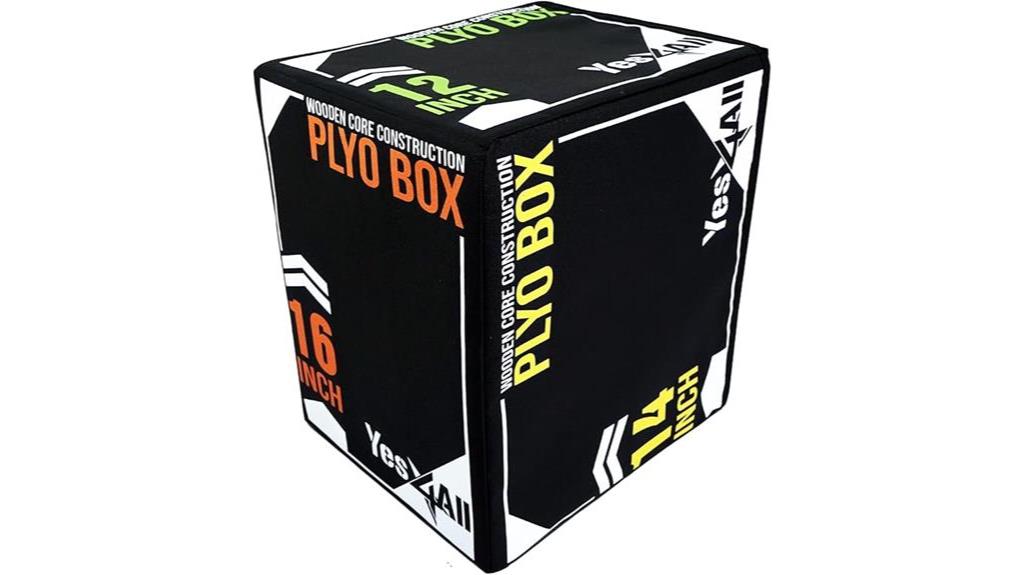
The Yes4All 3-in-1 Soft Plyo Box is great for anyone who wants to improve their jumping and strength. It has three different heights you can adjust to change how hard your workout is. The box has a wooden core with foam on top, so it's stable and less likely to cause injuries.
The non-slip PVC surface and 440-lb weight limit make it safe for intense workouts. You can use it for HIIT, box jumps, step-ups, and more. It's easy to clean thanks to the vinyl cover. Plus, it's lightweight, so you can store it or move it around easily. You don't need to put anything together – it's ready to use right away, just like the ones at the gym.
This plyo box is perfect if you want to get better at plyometrics and build strength safely with a versatile tool. The main benefits are:
- 3 adjustable heights for different workout intensities
- Stable foam-covered wooden core to reduce injury risk
- Supports up to 440 lbs, which works for most people
A few drawbacks to keep in mind:
- Some people say it feels a bit unstable because it's narrow
- The price might seem high to some, especially for bigger sizes
- It could take up too much space in a small home gym
3-in-1 Foam Plyometric Jump Box for HIIT and Fitness Training
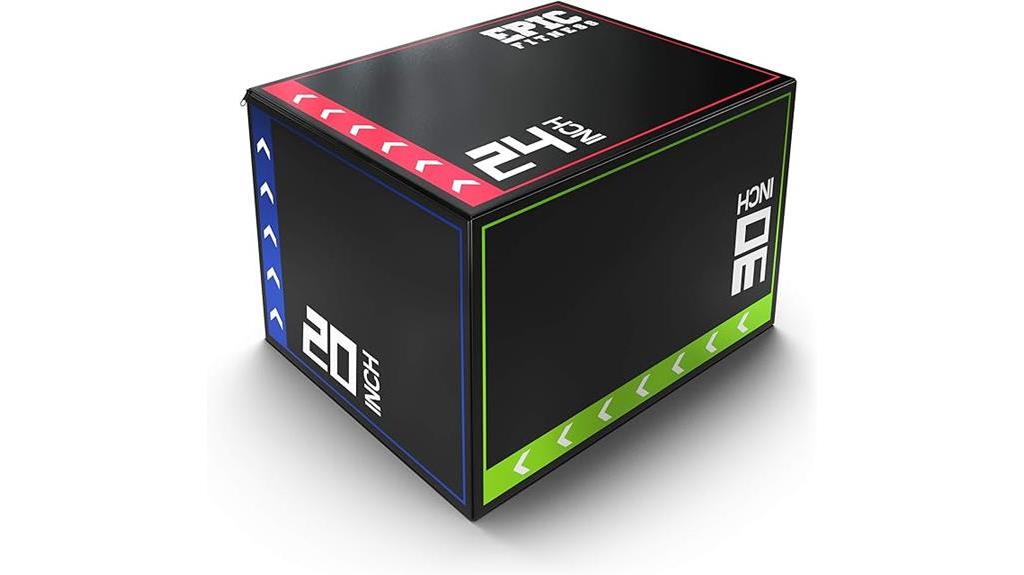
The 3-in-1 Foam Plyometric Jump Box is great for HIIT and fitness training. It comes in three heights: 20, 24, and 30 inches. This lets you change up your workouts and make them easier or harder.
The box has a foam core that's soft to land on. This helps keep you from getting hurt during tough plyometric exercises. It also has a PVC leather cover that won't slip. This makes it stable and easy to clean, so you can use it at home or at a gym.
The box is light, so it's simple to move and store. It may not be as strong as a wooden box, but it still works well for exercises like arm and core workouts. Just know that the foam might squish down if you put a lot of weight on it, especially when it's set to a higher height. To get the best results, use it on a surface that won't let it slide around during your workouts.
This jump box is best for:
– People who want a safe, adjustable box for home or personal gym use
Pros:
- Comes in three heights for different workout challenges
- Lightweight and easy to move and store
- Soft foam reduces injury risk
Cons:
- Foam may compress under heavy weight, especially at taller heights
- Not the best for rebounding box jumps since it's soft
- The vinyl cover and zippers might show wear over time if used a lot
VEVOR 3-in-1 Plyometric Jump Box for Fitness Training
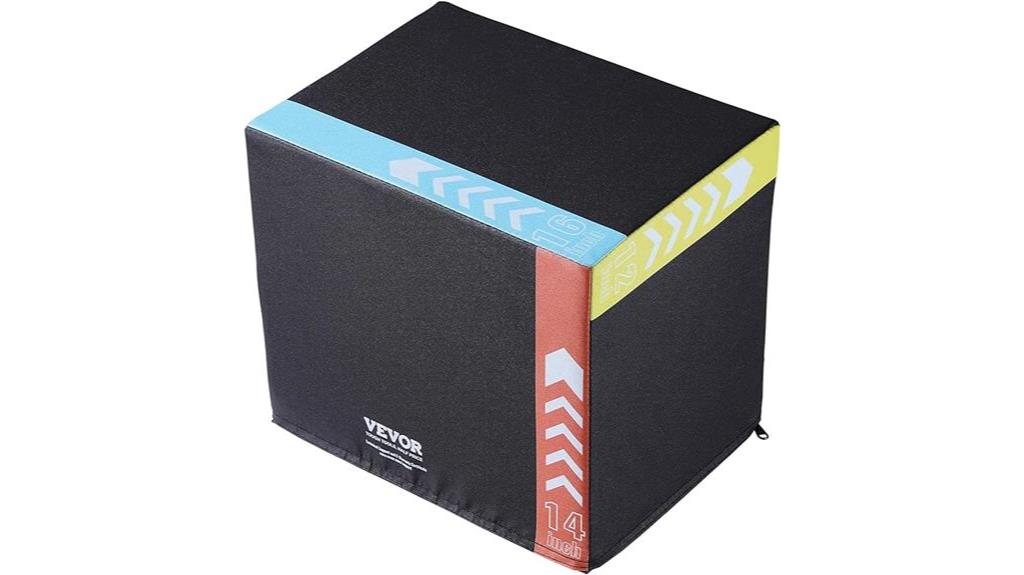
The VEVOR 3-in-1 Plyometric Jump Box is a great choice for anyone who wants to get fit, no matter their skill level. It has three different heights you can adjust, so you can use it for step-ups, push-ups, and deep squats. The box has a non-slip surface with a strong grip, so you won't slip during tough workouts.
Some people like how soft the landing surface is and how you can use it for different exercises. But others think it might be too small or not stable enough. Make sure to check the size before you buy it to see if it's right for you. The box is lightweight, so it's easy to move around, which is perfect for home gyms. It can hold up to 220 pounds and has a PVC cover that's easy to clean.
This plyometric box is best for people who want a workout tool that can do a lot of things and doesn't take up too much space at home or during personal training sessions.
What's great:
- You can change the height to make your workouts harder or easier
- The soft landing surface means you're less likely to get hurt during intense exercises
- It's easy to clean and take care of because of the PVC cover and zipper
What's not so great:
- Some people say it might not be stable enough, especially during tough workouts
- It might be smaller than you expect
- There are mixed reviews about how sturdy and long-lasting it is
REP FITNESS Unassembled 3-in-1 Wood Plyometric Box for Jump Training
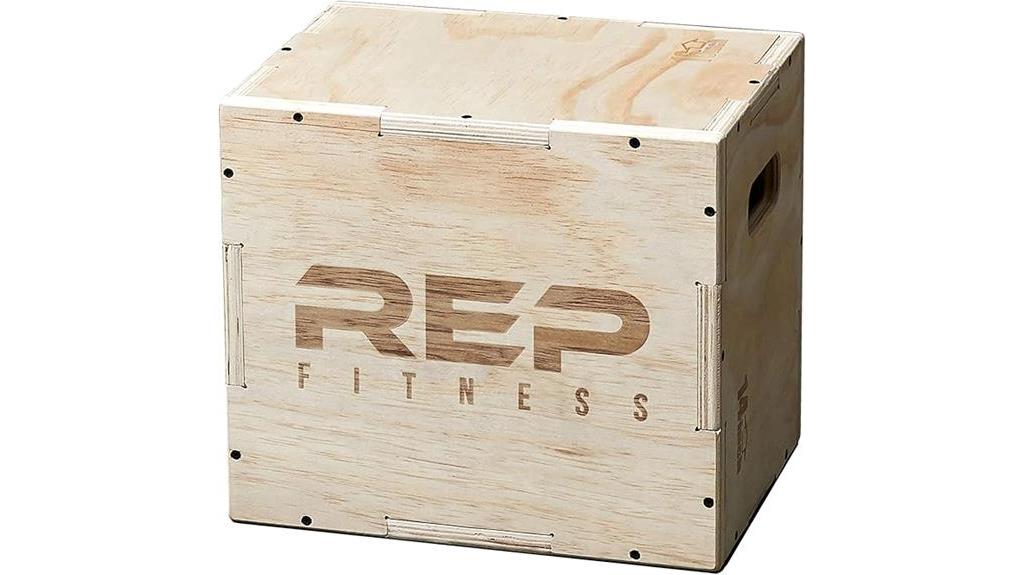
The REP FITNESS Unassembled 3-in-1 Wood Plyometric Box is perfect for anyone who wants to mix up their jump training. This box comes unassembled and has three different height options in one package. It measures 30 x 24 x 20 inches and only weighs 16 pounds, so it's easy to store and move around your workout area.
The box is made with high-quality ¾" plywood that can hold up to 400 pounds. Putting it together is easy and takes less than 30 minutes. It comes with pre-drilled holes and screws. The different heights let you change up your workouts, like doing box jumps to improve conditioning or box squats to build leg strength.
People who use this box say it's sturdy and stable, which makes it safe for different exercises. Some suggest using wood glue when putting it together to make it even stronger. With its great design and performance, this plyometric box is a perfect addition to your home gym.
This box is best for people of all fitness levels who want a versatile, stable, and compact plyometric box for jump training and strength exercises at home or in a gym.
Pros:
- Offers three height options in one design for different workouts
- Made with high-quality plywood that can support up to 400 pounds
- Simple to put together with clear instructions and pre-drilled holes
Cons:
- You have to assemble it yourself, which might be inconvenient for some people
- Wood might not last as long as metal boxes
- Some users recommend using wood glue for extra stability, which is an extra step
BalanceFrom 3-in-1 Rotatable Plyometric Box for Exercise and Workouts
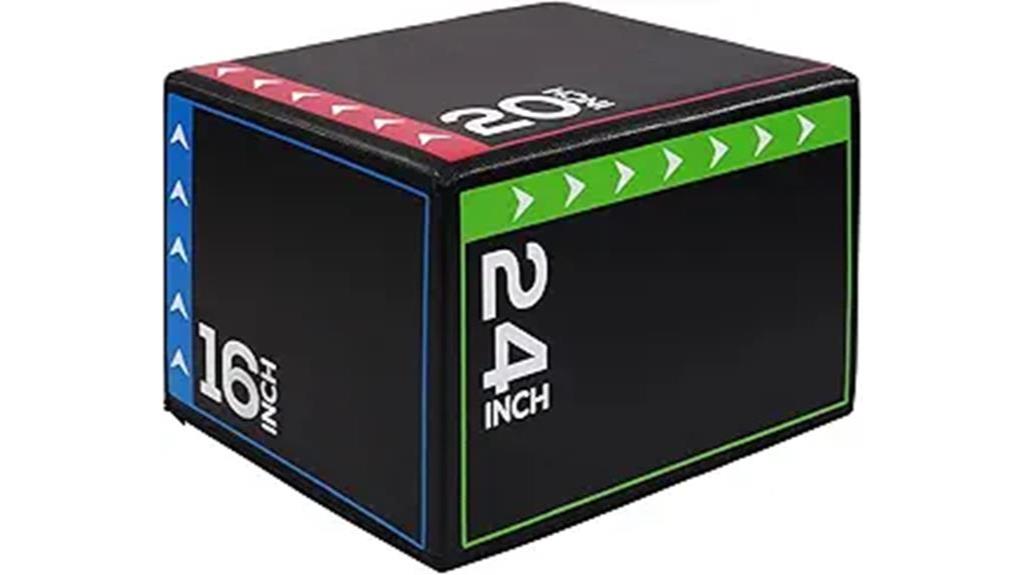
The BalanceFrom 3-in-1 Rotatable Plyometric Box is a great tool for athletes who want to improve their explosive power. This box can be set to different heights: 20", 24", and 30" (or 16"). This lets you change your workouts to fit your needs. The box is made of strong foam, which is safer than wooden boxes and lowers the chance of getting hurt during tough plyometric exercises.
The surface of the box is anti-slip, so you can feel stable and confident while working out. People who use it say it's high-quality, durable, and keeps its shape well. They think it's a good investment for personal or gym use. Some people say to be careful when using it at its highest setting, but many think it works well for different exercises and fitness levels. No matter if you're new to exercise or a seasoned athlete, this plyometric box can help you get better at explosive movements and overall performance.
This box is best for athletes and fitness fans of all levels who want to get better at explosive power and add plyometric exercises to their workouts.
Pros:
- Can be set to different heights for various exercises and skill levels
- Made of strong foam for safety and to prevent injuries
- Anti-slip surface keeps you stable during intense workouts
Cons:
- Some users say to be careful when using it at its highest setting
- Might be pricey for some, so it's good to wait for sales or deals
- Heavier versions (60 lbs) could be hard for some users to move or rotate
Factors to Consider When Choosing Plyometric Boxes for Jump Training
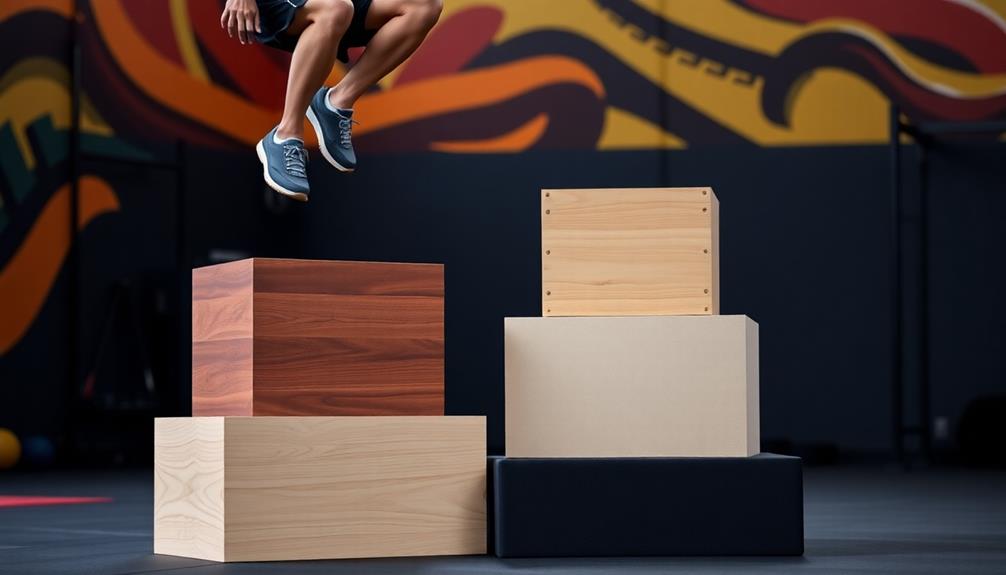
When you're in the market for plyometric boxes, there are several key factors you'll want to ponder. You should think about the material and construction, height adjustability options, and stability and safety features. It's also important to take into consideration the weight capacity, as well as the size and portability of the boxes to guarantee they fit your specific training needs and space constraints.
Material and Construction
When picking a plyometric box for jump training, focus on three main things: the material it's made of, how well it's built, and how safe it is to use. You can find boxes made of wood, foam, or metal. Each material has its own pros and cons for durability and stability. Think about what you need and how intense your workouts will be.
It's crucial that the box is constructed well for both performance and safety. The best boxes have strong corners, surfaces that won't let you slip, and can handle a lot of weight. The inside of the box should be tough, using high-quality plywood or dense foam. This way, it can take the impact of your jumps and keep you steady during different exercises.
Pay attention to what the surface is covered with too. Vinyl or PVC works great because it's a cinch to clean, won't scratch you up, and gives you a good grip so you don't slip during workouts. To stay safe, choose a box that's put together securely, has no sharp edges, and has enough padding. These features help prevent injuries and ensure your plyometric box lasts a long time.
Height Adjustability Options
Adjustable height is a must-have feature when buying a plyometric box. 3-in-1 boxes are great because they let you change the height from around 20" to 30". This means you can use the same box for different exercises and fitness levels.
Benefits of adjustable heights:
- Do lots of exercises with one box, from easy step-ups to tough box jumps.
- Make workouts harder as you get stronger by increasing the height. This helps you keep improving.
- Set the height that's right for you, whether you're new to exercise or a pro athlete.
- Stay safe by starting low and going higher gradually. Build confidence as you go.
Stability and Safety Features
Stability and safety are key when picking plyometric boxes. Non-slip surfaces keep you steady during tough workouts. Foam or wood cores strike a balance between toughness and safety, lowering injury risk if you miss a jump. Check weight limits to make sure the box handles your body weight and exercise impacts.
Safety first! Rounded edges prevent injuries if you bump the box. Sturdy build keeps things stable. Think about how safety features fit your needs and exercises. With a stable, durable, safe box, you can focus on training without worrying about accidents or breaks.
Weight Capacity
When choosing a plyometric box for jump training, it's important to consider the weight limit. Make sure the box can handle your body weight and any extra resistance you might use. Most good plyo boxes can support between 220lbs and 440lbs. Pick one that matches your fitness level and training intensity.
If you're heavier or an advanced athlete, go for a box with a higher weight limit. These boxes are more stable and durable, which is important for safety and performance. Plyometric exercises involve dynamic movements and impacts, so your box needs to handle these forces well.
Think about your future needs, not just your current ones. If you plan to progress in your training or use weighted vests, choose a box with a higher limit. Always check the manufacturer's specifications and play it safe.
Size and Portability
When choosing a plyometric box, consider its size and portability. Make sure the box fits well in your workout area by measuring the available space and comparing it to the box's dimensions.
If you need to move or store the box, look for portable features like handles or a lightweight design. Some boxes even have wheels for easy transport.
Adjustable or stackable boxes are great for small spaces. You can change the height for different exercises and fitness levels, and they take up less room when stored.
Keep in mind that a portable box should still be stable enough for safe jumping. Choose boxes made from strong materials that can handle repeated use.
Intended Use
When choosing a plyometric box, think about how you'll use it. Different exercises like box jumps, step-ups, and depth jumps need boxes of varying heights and strengths.
For home workouts, a smaller box that's easy to put away might be best. But gym owners will want tougher boxes that can handle lots of use by many people.
Make sure the box can hold your weight and is stable during intense movements. Non-slip surfaces and strong materials prevent injuries.
Adjustable boxes let you change the height for different exercises and harder workouts over time. Wood boxes are sturdy but heavy, while foam boxes have softer landings but may not last as long.
Price and Value
Price is important when choosing plyometric boxes for jump training. You can find foam boxes that are cheaper or wooden boxes that cost more. Think about how long the box will last, how much weight it can hold, and how many ways you can use it.
Compare the prices of different boxes and look at their quality and features. A more expensive box might be sturdier and last longer, which could be a good investment. But don't forget about cheaper options that might still work well for you.
Look for sales or discounts on the plyo box you want. This can help you get a better box for a lower price.
Think about what you want to achieve with your training and choose a box that fits your needs. A box that is perfect for you and lasts a long time might be worth paying more for. The right plyo box can make a big difference in your jump training and is a valuable piece of equipment.
Frequently Asked Questions
How Often Should I Replace My Plyometric Box?
You don't need to replace your plyometric box often if it's well-maintained. Check it regularly for wear and tear. If you notice significant damage or instability, it's time to replace it. Generally, a quality box can last years.
Can Plyometric Boxes Be Used for Exercises Other Than Jumping?
Yes, you can use plyometric boxes for more than just jumping. They're versatile tools for various exercises like step-ups, dips, incline push-ups, and box squats. You'll find them useful for both lower and upper body workouts.
Are Plyometric Boxes Suitable for Outdoor Use?
You can use plyometric boxes outdoors, but you'll need to take the weather into account. Some are weather-resistant, while others aren't. If you're using them outside, look for durable materials and make sure they're on a stable surface.
What's the Weight Limit for Most Plyometric Boxes?
You'll find most plyometric boxes can support 300-400 pounds safely. However, it's best to check the manufacturer's specifications for your specific box. Don't exceed the weight limit to guarantee your safety during workouts.
How Do I Clean and Maintain My Plyometric Box?
To clean your plyometric box, wipe it down with a damp cloth and mild soap after each use. You'll want to dry it thoroughly to prevent moisture damage. Regularly check for loose screws or wear, tightening or repairing as needed.

